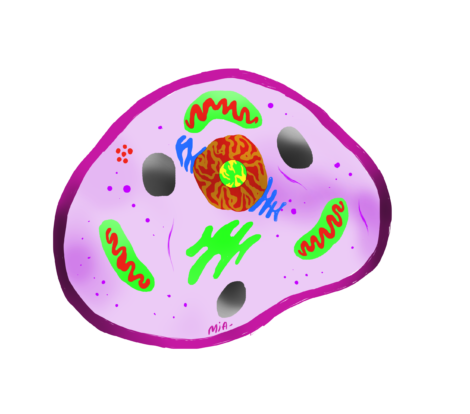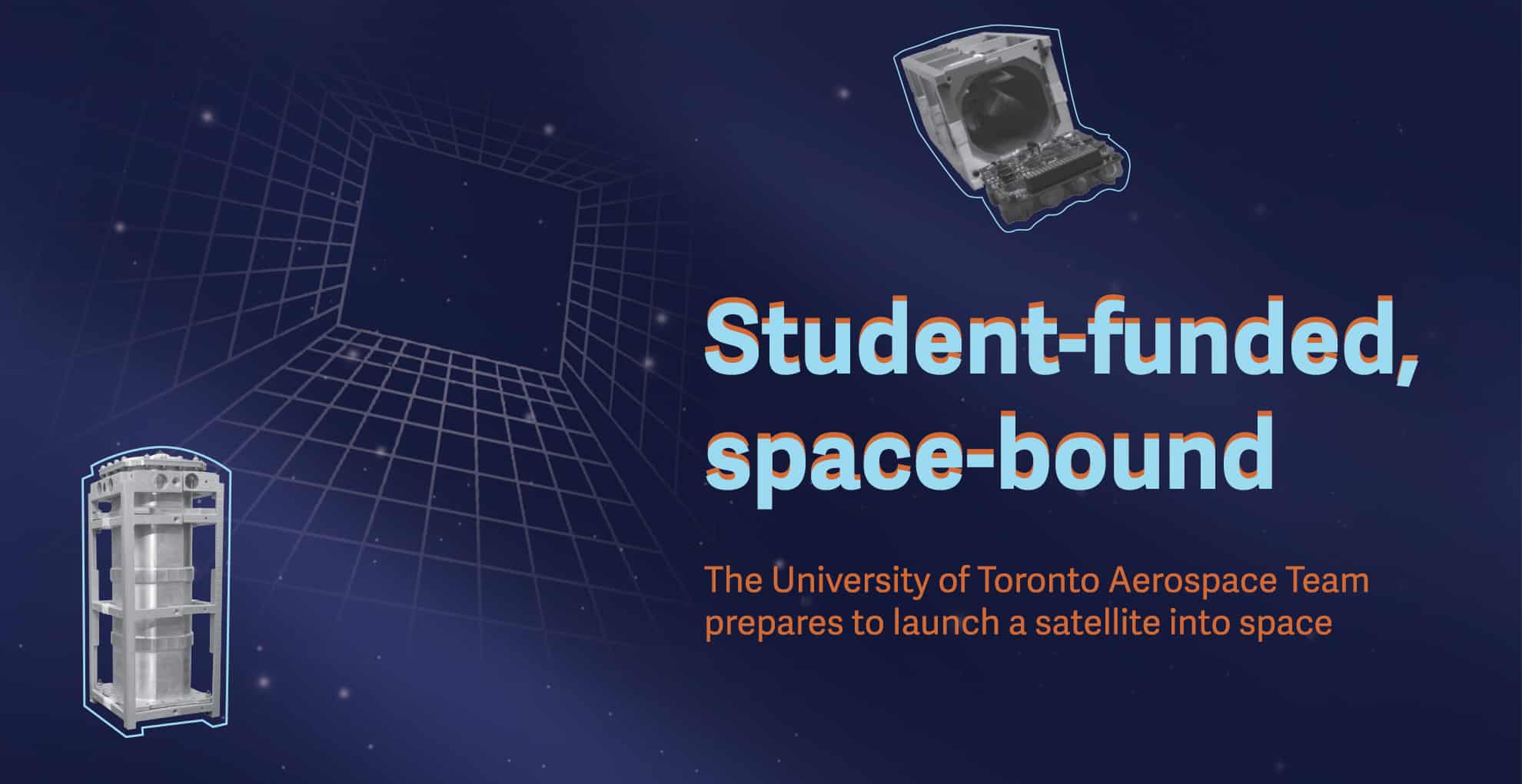Article by Mari Ramsawakh
The University of Toronto may make its claim to space following the U of T Aerospace Team’s (UTAT) successful levy referendum last spring. The money from the levy goes toward its Innovation Fund, which was established to create a new project for UTAT: a student-built and student-funded satellite to launch into space. Members of the University of Toronto Students’ Union (UTSU) from UTSG will pay the $2.77 per term levy over the next two years.UTAT is a student-run research and design group that aims to incite curiosity and spark interest in aerospace engineering. While the satellite is UTAT’s latest project, the Space Systems Division is only one of several branches of the group. The group also has a Rocketry Division currently working on a hybrid rocket that could break Canada’s high altitude record and an Unmanned Aerial Vehicles Division that is currently the defending champion of the Unmanned Systems Canada competition.
So, how has UTAT been using the Innovation Fund since its inception? How is the satellite coming? I met with UTAT at their office in McLennan Physical Laboratories to find out.
The team
The office, located in the basement of the building, snugly fits five of the Space Systems team members. Every workspace is covered in small plastic and metal components, which were later identified to me as 3D-printed prototypes of components of the satellite.
Although the whole Space Systems Division couldn’t meet with me, several of the Division’s team leads met to tell me more about the satellite project. Before delving into UTAT’s specific plans, I spent some time getting to know a little bit about how these undergraduates got involved with aerospace design.
Ridwan Howlader is a prime example of the sort of trajectory that UTAT can inspire; he’s the Executive Director of UTAT and the Senior Engineering Designer for the Space Systems Division. Howlader first joined UTAT during one of its outreach programs run through high schools — this means he’s been with UTAT longer than he’s been at U of T. As Executive Director, Howlader is part of the strategic and technical planning of all the projects that UTAT is involved in.
“I really appreciate the members and the energy and being curious and wanting to learn,” he told me. “It just aligns with our mission and vision.”
Katie Gwozdecky is the Director of Space Systems and a fifth-year engineering student. She’s in charge of the administrative details of the Space Systems Division, although her focus has shifted away from her initial interest in the technical aspects of the work and toward the team’s culture and keeping them aligned with their passions and needs.
“I think that no team can operate at their best if people aren’t considered to be contributors in any way,” said Gwozdecky. “We also have to make sure that people are given the space they need to do what they want to do.”
Gwozdecky has been with UTAT for five years, initially discovering the group in her first year. She explained that from the moment she saw the rockets at a clubs fair, she knew this was a group she wanted to join. Gwozdecky has been with the Space Systems Division since its creation.
Addy Bhatia, the System Design and Attitude Control Lead, has been with UTAT since fall of last year. The third-year engineering student was determined to join the team and jumped at an opportunity when he could. Now, his role involves figuring out how and where the satellite points as it separates from the rocket, as well as mechanical integrations of smaller projects into the satellite.
Victor Nechita is an aerospace engineering student who has also only been working with UTAT for the last year. Nechita is the Project Manager of the Space Systems Division, meaning that he is the one in charge of managing deadlines and scheduling as well as liaising with their launch providers.
“Your task is not just limited to a competition, we kind of extend beyond that in that we’re trying to have a real impact on the world by creating an open platform for these microbiology experiments,” said Nechita. “Being able to conduct that as a student team has been fantastic, so I hands down love being a part of the team.”
Avinash Mukkala, the Payload Lead, is a member of the team who isn’t focusing so much on the satellite, but rather the experiment for which it’ll be collecting data. Mukkala is a fourth-year molecular genetics student who joined during the first iteration of the satellite three years ago. As much as team culture has taken precedent in this group, Mukkala found that he was most proud of the scientific and technological progress UTAT has actually made on the satellite since its first iteration.
“It isn’t just a bunch of students that are just building something and putting it into space,” explained Mukkala. “There is a lot of advisors involved, there’s a lot of critical design reviews involved. The process is what I enjoy.”
They also get to learn from real experts in their fields. For example, shortly after meeting with me, several leads on the team travelled to Huntsville, Alabama to attend a NASA conference.
The mission
The first iteration of the satellite was designed for the Canadian Satellite Design Challenge, in which universities across Canada were challenged to design a satellite in a two-year cycle that, once built, could survive the rigorous qualifying testing in order to win the competition. While the contest originally promised that the winning designs would be launched, there weren’t any formal offers to actually launch the satellites. UTAT decided to take the launch into their own hands.
But as Mukkala said, UTAT is more than just a couple of students sending something into space for bragging rights. There is a purpose to the satellite and its launch: a microbiology experiment.
The purpose of the satellite is to send up a payload of genetically modified cells and examine how they grow and react to an environment that is under the effect of microgravity. Mukkala was part of the team that genetically engineered the cells to send up into space. The cells they are using are a form of yeast that is found in the human gut, called candida albicans.
According to Mukkala and Bhatia, there have been several studies from NASA and other researchers that suggest that astronauts who experience long-duration space flight in microgravity can experience immunological changes because of the upregulation of the expression of certain genes in their T-cells and B-cells.
Mukkala said that space is very sterile, but our own bodies contain bacteria, and long space flights require more than one astronaut. If an astronaut is immunocompromised — meaning their immune system is impaired — they can become more susceptible to urinary tract infections or other kinds of infections. Bhatia added that this is a significant concern because, in these situations, necessary medical aid is not accessible in space.
The yeast cells will be loaded onto the UTAT satellite and examined to see how much the genes change over the course of two days in orbit. The sensors they’ll be using in the satellite have already demonstrated that they can be used in a space-like environment and can produce reproducible results. If these studies go on to prove the theories put forth by NASA and other scientists, then similar studies can continue to explore how medications may behave differently in space.
“For that reason we’re putting together a very small-scale, cheap platform that students like us can build and keep on building in the future across the world, to do studies that are as significant as this to the scientific and space community, that would benefit future space exploration,” explained Bhatia.
“Something else to note is that the results that we get from an experiment are usually applicable to more than just one situation,” added Mukkala. “Science is very spontaneous. Things happen as they go. It’s a matter of developing technology that can pace with the spontaneity of science.”
The Innovation Fund was planned to serve only on the Space Systems project and the satellite launch. According to Howlader, a large portion of the levy will be used for the launch costs, which can be “hundreds of thousands of dollars” paid through several installments over the two-year period. All other funds go directly into designing and developing the satellite.
While the first iteration that was built for the design competition withstood the structural testing that it required, the designers of the Space Systems Division found that it was difficult to manufacture and develop. That’s why the satellite has now entered its second iteration; included in this iteration is a new outer design of the satellite. Additionally, each system is being designed to be prototyped and manufactured more quickly.

The future
The true importance of a project like this is not in the immediate results of the launch but rather in the longevity of the project and the doors that it will open. The purpose of UTAT is to get students not only excited about aerospace engineering, but to make it more accessible. UTAT wants to create an environment where students can learn outside the classroom and put the theories they have learned into practice.
“The ability to show that students at the undergraduate level can get involved very deeply into something that only people like NASA have done before is very, very big,” said Howlader.
UTAT is more than just for students in STEM fields. Students involved in commerce, marketing, finance, and outreach can get involved to work on the business development aspect to the group.
“We have an entire system that can be for anyone who has any curiosity to come and learn this stuff,” Howlader told me. “I think a really big thing is how interdisciplinary the aerospace community really is.”
The Ontario Science Centre is already using old UTAT equipment for educational purposes. It’s only a matter of time before the first U of T student-launched satellite becomes the next attraction.




